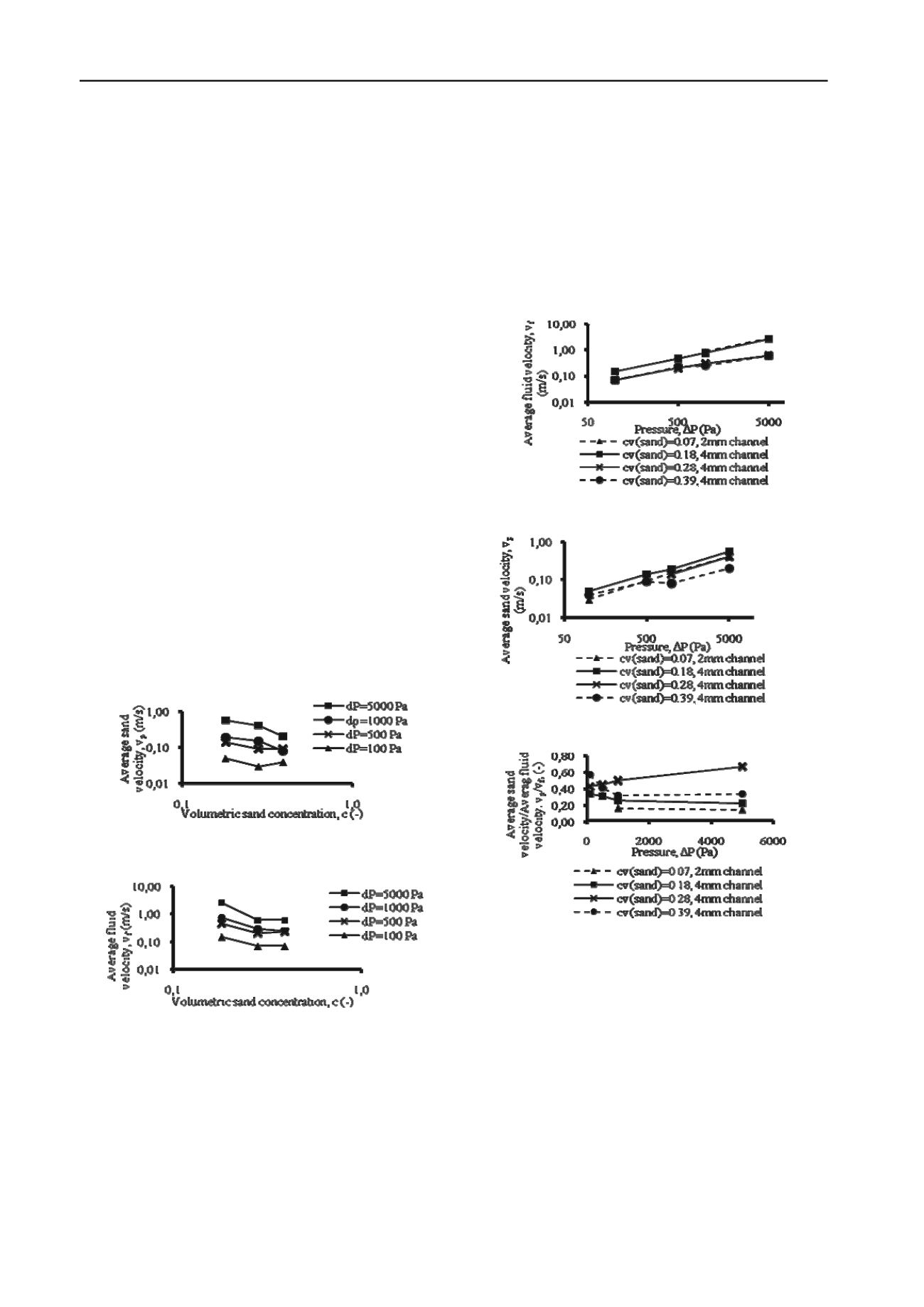
1049
Technical Committee 105 /
Comité technique 105
and before impact. At low approaching velocities lubrication
effect prevails and significantly decreases particle rebound
at higher impact velocities lubrication effect
lastic rebound so much.
was
est
nd concentrations. Fluid velocity
decreases with concentration increase, following similar paths
for all pressure differences.
velocity, while
does not affect e
3 RESULTS
A study of 30 mesh sand flow in a narrow 2 mm and 4 mm wide
and 0.5 m long channels reveals behavior of sand slurry flow
obstructed with particle-particle interactions and particle-wall
interactions caused by concentration and ratio of channel width
and particle diameter. The study is simplified with respect to
using a uniform particle size distribution and coarse
discretization of the CFD-DEM fixed grid. Only two grid
elements across the width of the narrow channel are able to be
used in CFD scheme in order to keep the accuracy of the
coupling with respect to the particle size. Boundary conditions
of the flow are constricted to the non-slip conditions at the
channel upper and lower boundary with zero fluid velocity, and
a pressure difference
P
between the enter and exit profiles of
the channel. Average fluid and sand velocites are measured
across some fixed volume in the channel after the flow
ablished. In a narrow channel, sand velocities are obstructed
by formation of particle packs and solids-wall interactions.
Velocity of sand is always smaller than velocity of
surrounding fluid, indicating that fluid flows arround the sand
particles or packs that move with the fluid, but at slower
velocity. Pressure and sand concentration effect on sand
velocity in the narrow channel is studied. Fig. 4 shows the
change of sand velocity under different presssure differences
and sand concentrations. Average sand velocity in the channel
decreases with particle concentration increase, but does not
follow the same law for higher and lower (dp<500Pa) pressures.
Fig. 5 shows the change of fluid velocity under different
presssure differences and sa
F
pressures
igure 4. Sand velocity dependence on concentration at different
Fig
(
c
ll the
observed cases had velocities low enough for the flow to be
considered laminar. (This can be seen in Figs. 6 and 7.)
ure 5. Sand velocity dependence on concentration at different
pressures
Figs. 6 and 7 indicate that both sand and fluid follow the
power-law dependence of velocity on sand concentration in log-
log plot. The velocity slopes in log-log plot are parallel and
increase with pressure decrease. However, if the sand velocity
and fluid velocity ratio is observed, it seems that it generally
rapidly decreases with pressure increase (Fig. 8) and then
approaches steady value at very high pressures. This behavior
can be related to stability of the flow and forming of particles
clumps that force fluid to flow arround them. When fluid flows
arround clumps, it flows in narrow channel and its velocity
localy inceases because of that. Pressure increase enhances the
frequency of particle collisions, whose damping causes
agglomeration. Results shown in Fig. 8 indicate, as well, that
velocities ratio depends on particles concentrations, not only on
channel pressure. For higher initial particles concentrations
v
=0.39) solids and fluid velocity ratio is more sensitive on
pressure change than for lower initial concentrations (
c
v
=0.18).
Higher sand concentrations obstruct the increase of fluid
phase flow velocity expected with pressure increase, as well as
sand phase velocity increase, while lower concentrations have
different impact on pressure dependent velocity. A
Figure 6. Average fluid velocity change with pressure
Figure 7. Average sand velocity change with pressure
igF
. 8) at a
given shear rate are investigated here with respect of fluid and
sand phase separately. Non-
ure 8. Average sand velocity and average fluid velocity ratio change
with pressure
Attempts were made in the past to describe the sand slurry
flow using the equivalent non-Newtonian parameters dependent
on fluid and particle phase characteristics, such as fluid
viscosity and sand volumetric concentration (Shah, 1993). The
proposed formulation was based on the assumption that fluid
and sand have the same velocities in the flow. However, here is
shown that this assumption is not valid for the narrow channel
and higher sand concentrations. The non-Newtonian parameters
K’
and
n’
that form apparent viscosity of the slurry (Eq
Newtonian fluid low is:
(8)
where
=shear stress,
=shear rate,
K
=non-Newtonian fluid
consistency index,
n
=non-Newtonian fluid flow-behavior index,
K K
1
'
n
n
n
a
K


